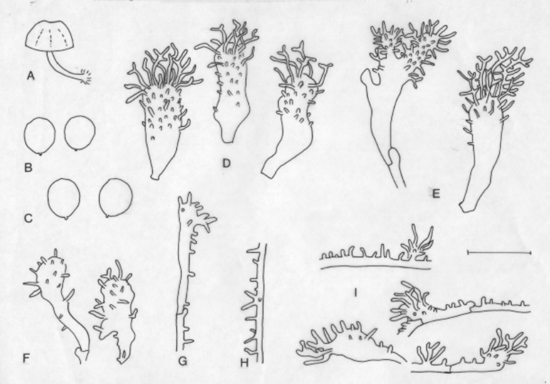Scattered or in small groups on (sometimes
moss covered) bark of living Juniperus communis, mostly the prostrate type along the coast.
Also collected on Juniperus excelsa and J. oxycedrus and very rarely on other hosts. Late autumn to winter (mild periodes). Although, recently described, known from Norway, Sweden, Denmark, Estonia, Poland, France, Bulgaria, and UK. Also known from Greece, Italy, Macedonia, Spain and Turkey. Regular in the type locality. Rare or possibly overlooked and locally more common in coastal Juniperus shrubs in Norway. Also recorded ininland localities.
Pileus 2.5-8 mm
across, hemispherical to parabolical, finally convex, occasionally
somewhat depressed in the centre or with a small papilla,
conspicuously sulcate, pruinose to white-puberulous or even
somewhat flocculose, pale brown or yellowish brown, often
darker in the centre, with the margin paler to white. Flesh
very thin, whitish. Odour not
distinct or somewhat acidulous. Taste mild, not distinct.
Lamellae (7-)10-12 reaching
the stipe, fairly broad, somewhat ascending or arcuate to
subhorizontal, the edge concave to convex, broadly adnate
with a decurrent tooth, sometimes decurrent far down the
stipe, pale yellowish grey or beige with the edge white-pruinose.
Stipe 3-5 x c. 0,5 mm, equal
or somewhat widened below the lamellae, and sometimes also
towards the base, terete, curved, cartilaginous, fistulose,
pruinose to puberulous, beige to pale brown, the base attached
to the substratum with a patch of radiating, fine whitish
fibrils.
Basidia 33-40 x 11-13.5
um, clavate, 4-spored, clamped, with sterigmata up to 8
um long. Spores 8.8-12.3 x 8.1-10.5 um, Q 1.0-1.3, Qav ~ 1.1, subglobose to globose, smooth, amyloid. Cheilocystidia
22-40 x 7-11,5 um, forming a sterile band (lamellar
edge homogenous), clavate, covered with unevenly spaced,
simple to branched, curved to tortuous, often irregularly
shaped excrescences, 2-23 x 0,7-1,5 um, clamped. Pleurocystidia
absent. Lamellar trama dextrinoid, brownish
vinescent in Melzer's reagent. Hyphae of the
pileipellis 1,8-11,5 um wide, clamped, with
cylindrical, often curved, simple to branched excrescences
which may grow to coralloid masses. Hyphae of
the cortical layer of the stipe 1,5-3,8
um wide, with cylindrical excrescences 1-6 x 1,5 um, clamped,
terminal cells abundant, 23-43 um long, clavate, variously diverticulate.

A. Basidiome; B, C. Spores; D,
E. Cheilocystidia; F, G. Terminal cells of the cortical
layer of the stipe; H. cortical layer of the stipe,
I. Hyphae of the pileipellis with terminal cells. |
Mycena juniperina has surprisingly
proved to be a fairly common species in the type locality.
It shows up late in the autumn, growing on bark of living
Juniper. It is easily recognized as a member of
section Supinae, but can be distinguished from the other
members of the section on account of the colour of the pileus,
and the growth on Juniper. The microscopic characters
show similarities to the widely distributed species
Mycena meliigena and Mycena
pseudocorticola, but, among several
differences, those species grow exclusively on bark of deciduous
trees, and they have a different colour of both pileus
and stipe. Mycena cupressina Antonín
& Maas Geest., recently described from Italy (Antonín
& Maas Geesteranus 1998), has a similar, ochraceous coloured
carpophore, but is supposed to differ from M. juniperina by having
smooth hyphae of the stipitipellis, and growth on Cupressus
sempervirens. The differences seem somewhat marginal, and it is a question if M. cupressina is a species of its own right, especially since the relationship to M. juniperina was not at all discussed in the paper proposing the new species, indicating that the authors were not aware of its existence. Assyov (2022) studied collections identified as M. cupressina from Bulgaria and claimed that the smooth hyphae of the stipitipellis could be used to distinguish it from M. juniperina. He suggested retaining it as a separate species, but the obtained ITS sequence is not at all convincing, showing 99,39% similarity with the type of M. juniperina. He indicated that ITS may not be a suitable marker for resolving phylogenetic relationships in sect. Supinae.
J. Miersch recorded M. juniperina in Gotland, Sweden 23 Sept. 1999 (Kummer & Miersch 1999),
and M. Jadner & M. Krikorev found it in Sweden,
Östergötland, Linköping 2000-11-04 (Krikorev,
pers. comm.). Robich (2003: 661) mentioned three collections
from Italy. Recently Læssøe (2005) recorded
it in Denmark. He also referred to a record from Öland,
Sweden. Dogan & Karadelev (2006) recorded it from Turkey
on a new host, Juniperus excelsa. In 2007 it was recorded in Estonia (Tõnu Ploompuu, pers. comm.). In 2009 it was also recorded in France on Juniperus oxycedrus. Pérez-de-Gregorio i Capella et al. (2009: 54-59) recorded M. juniperina on Juniperus communis and J. oxycedrus in Spain and did also report the new host Arbutus unedo. They also made one collection on J. phoenicea. Halama et al. (2014) reported this species from Poland and discussed both ecology and distribution. It was recorded for the first time in the UK November 2015.
|